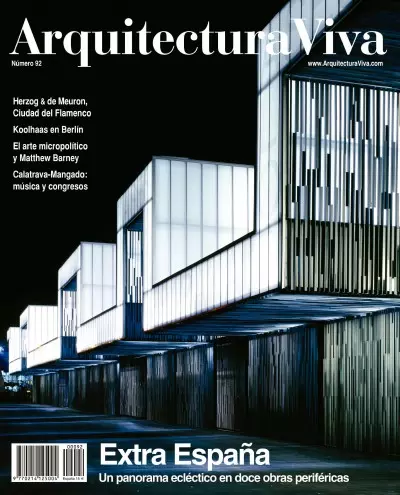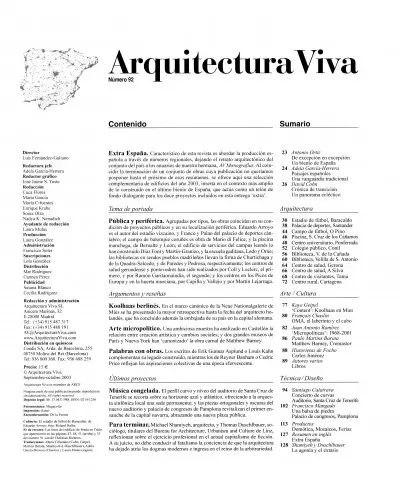Synopses
Extra Spain. On these pages, we are used to reviewing Spanish architecture through regional issues, leaving the coverage of the entire country to the yearbooks of our sister magazine, AV Monographs. The simultaneous completion of a series of works whose publication we did not wish to postpone until the next yearbook has prompted us to include here a complementary selection of buildings of the year 2003, placed in the broader context of what has been built in the last two years in Spain, a period that serves as a backdrop of dialogue for the twelve projects included in this ‘extra’ release.
Contents
Antonio Ortiz
From Exception to Exception
Two Years of Spain
Adela García-Herrera
Spanish Landscapes
A Traditional Avant-Garde
David Cohn
Chronicle of Transition
An Eclectic Panorama
Cover Story
Public and Peripheral. Grouped by building type, the works coincide in being public projects and in their peripheral location. Eduardo Arroyo is the author of the Basque stadium, and Franco & Palao of the Cantabrian sports center; the soccer field in La Coruña is a work by Mario di Felice, and the pool in La Mancha, of Bernalte & León; the hall in the campus of Ponferrada has been designed by Díaz Font & Martín-Granizo, and the school in Cádiz, by Ledo & Orúe; the libraries in two villages near Madrid are signed by Churtichaga & de la Quadra-Salcedo, and by Paredes & Pedrosa, respectively; the health centers in Gerona and Pontevedra have been built by Coll & Leclerc, the former, and by Ramón Garitaonaindía, the latter; and the centers of the Picos de Europa and Murcia, by Capilla & Vallejo and by Martín Lejarraga.
Architecture
Soccer Stadium, Baracaldo
Sports Center, Santander
Soccer Field, O Pino
Pool, S. Cruz de los Cáñamos
University Hall, Ponferrada
Public School, Conil
Library, V. de la Cañada
Library, Velilla de S. Antonio
Health Center, Gerona
Health Center, A Silva
Visitors’ Center, Tama
Rural Center, Cartagena
Views and Reviews
Berliner Koolhaas. Mies’s Neue Nationalgalerie has served as privileged context to display the greatest retrospective up to now on the Dutch architect, who has also opened the embassy of his country in the German capital.
Art / Culture
Kaye Geipel
Content: Koolhaas in Mies
François Chaslin
OMA, Labyrinth and Cube
Micropolitical Art. An ambitious exhibition in Castellón has analyzed the relationship between artistic creation and social change; and two museums of Paris and New York have ‘canonized’ the carnal work of Matthew Barney. Juan Antonio Ramírez
Micropolitics: 1968-2001
Paulo Martins Barata
Matthew Barney, CremasterWords with Works. T The writings of Erik Gunnar Asplund or Louis Kahn complement their built legacy, while those of Reyner Banham or Cedric Price reflect the collective aspirations of an effervescent period.
Focho’s Cartoon
Carlos Jiménez
Various Authors
Books
Recent Projects
Frozen Music. The curved and snow-white profile of the auditorium of Santa Cruz de Tenerife stands out against its blue and Atlantic horizon, offering the local symphony orchestra a permanent venue; and the orthogonal dark pieces of the new concert hall and congress center of Pamplona revitalize the first expansion of Navarre’s capital, embracing a new public square.
Technique / Style
Santiago Calatrava
Concert of Curves
Auditorium, S. Cruz de Tenerife
Francisco Mangado
A Stone Raft
Congress Center, Pamplona
To close, Michael Shamiyeh, architect, and Thomas Duschlbauer, sociologist, founders of the Bureau for Architecture, Urbanism and Culture of Linz, reflect on professional practice in the current fiction capitalism. As they see it, the awareness that architecture has left behind modern dogmas and is entering the realm of the arbitrary should not lead to hopeless fatalism. Products
Domotics, Mosaics, Fairs
Shamiyeh & Duschlbauer
Agony and Ecstasy
Luis Fernández-Galiano
Spain extra
Extra Spain or Spain extra? The ambiguity of the term allows to view the projects gathered in the issue as an additional compilation or as a fine collection: more Spain or extraordinary Spain? The increased Spain refers to the list of works that are customarily included in our sister magazine AV Monographs Yearbook, extended here by a series of recent peripheral works; and the splendid Spain should be taken as a selection of projects extracted from the mediocrity of our architectural environment. Late entries and exceptions, these works are extras in the casting of roles among the usual suspects, and at the same time show an extra quality that makes them stand out against the built landscape’s flat profile. Out of the canon and on the outskirts of the system, their virtue lies in being outside: outside the trite reiteration of praise and outside also the trivial subjection to routine.
If ‘extra’ is equivocal, ‘Spain’ is no less so. In the centrifugal atmosphere that the country lives today, the spontaneity with which we once referred to Spain has given rise to a cautious use that measures every nuance to avoid unintentional offence. When the fervor of nationalisms demands the division of the Peninsula into an archipelago of fragments, and when the accelerated Balkanization of the country is presented as fitting a blurred networked modernity, describing Spain from a center perceived as radial is perhaps daring. But on the axis of these threads that in the end are woven into a net, we represent Spain trying to avoid proximity from altering the likeness of the portrait: if the selection of projects turns out to be faulty, it shall not be for lack of curious search over the land which the Italian scholar Mario Praz once called ‘Pentagonal Peninsula’ and its Atlantic and Mediterranean islands.
This ephemeral anthology is not a representative sample of Spanish architecture, but a hint of the excellence of its best constructions, and an inventory of the features on which its global recognition is based. With the perspective that distance gives, and perhaps also with its inevitable imprecision, out of our provisional homeland the trademark Spain brings to mind the films of Almodóvar, the cuisine of Ferrán Adriá and the architecture of Calatrava; together with that black Osborne bull that graces the flags waved in sport fields, in the barracks of troops abroad or in the scientific station of Antarctica. May that Spain that has left behind the mater dolorosa of archaic nationalism, and which Newsweek proposes as a European model – The Spanish Way – know how to escape its familiar demons, replacing the lágrimas negras of Bebo and Cigala with the cositas buenas of Paco de Lucía. A few of them are presented here.








